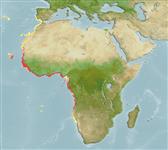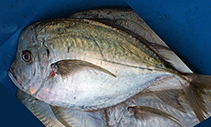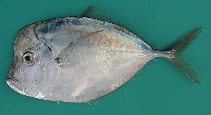個人による観察記録の追加 Fish Watcher
| Native range | All suitable habitat | Point map | Year 2050 |

|
| This map was computer-generated and has not yet been reviewed. |
| Selene dorsalis AquaMaps Data sources: GBIF OBIS |
Senegal country information
Common names:
Fanta, Fanta mbaî, Fanta mbaï
Occurrence: native
Salinity: brackish
Abundance: | Ref:
Importance: | Ref:
Aquaculture: | Ref:
Regulations: | Ref:
Uses: live export: yes;
Comments: Occurs in the Sine-Saloum Estuary and Senegal River (Ref. 28587). Also Ref. 3197, 57392.
National Checklist:
Country Information: https://www.cia.gov/library/publications/resources/the-world-factbook/geos/sg.html
National Fisheries Authority: http://www.refer.sn/sngal_ct/eco/oeps/
Occurrences: Occurrences Point map
Main Ref: Smith-Vaniz, W.F., 1986
National Database:
Occurrence: native
Salinity: brackish
Abundance: | Ref:
Importance: | Ref:
Aquaculture: | Ref:
Regulations: | Ref:
Uses: live export: yes;
Comments: Occurs in the Sine-Saloum Estuary and Senegal River (Ref. 28587). Also Ref. 3197, 57392.
National Checklist:
Country Information: https://www.cia.gov/library/publications/resources/the-world-factbook/geos/sg.html
National Fisheries Authority: http://www.refer.sn/sngal_ct/eco/oeps/
Occurrences: Occurrences Point map
Main Ref: Smith-Vaniz, W.F., 1986
National Database:
Common names from other countries
分類 / Names 共通名の | 類義語 | Catalog of Fishes(部類, 種) | ITIS | CoL | WoRMS | Cloffa
> Carangiformes (Jacks) > Carangidae (Jacks and pompanos) > Caranginae
Etymology: Selene: Greek, selene = moon (Ref. 45335).
More on author: Gill.
Etymology: Selene: Greek, selene = moon (Ref. 45335).
More on author: Gill.
Environment: milieu / climate zone / depth range / distribution range 生態学
分布 国々 | 国連食糧農業機関の区域 | エコシステム | 事件 | Point map | 導入 | Faunafri
Eastern Atlantic Ocean: Madeira, Canarias, Cabo Verde and from Senegal to Namibia. Replaced by Selene setapinnis in western Atlantic. These two species have not been adequately studied and may prove to be conspecific.
サイズ / 重さ / 年齢
Maturity: Lm ? range ? - ? cm
Max length : 40.0 cm TL オス/雌雄の選別がない; (Ref. 57392); common length : 24.0 cm FL オス/雌雄の選別がない; (Ref. 3195); 最大公表体重: 1.5 kg (Ref. 27584)
Max length : 40.0 cm TL オス/雌雄の選別がない; (Ref. 57392); common length : 24.0 cm FL オス/雌雄の選別がない; (Ref. 3195); 最大公表体重: 1.5 kg (Ref. 27584)
簡単な記述 検索表 | 形態学 | 形態計測学
背面の脊椎 (合計) : 9; 背鰭 (合計) : 23 - 24; 肛門の骨: 1 - 3; 臀鰭: 18 - 20. Diagnosis: body short, deep (depth comprised 1.7-2.3 times in fork length) and strongly compressed; head with a typical hump above eyes and a steep frontal profile that is slightly concave in front of eyes; lower jaw prominent; 2 dorsal fins, 1st with 8 spines that are very short in adults, 2nd with 1 spine and 23 or 24 soft rays; anal fin with 2 anterior detached spines (resorbed in adults), followed by 1 spine and 18-20 soft rays; anterior lobes of soft dorsal and anal fins small or indistinct; pelvic fins very short, nearly rudimentary; body (except breast) entirely covered with minute cycloid scales embedded in the skin; lateral line distinctly arched over pectoral fins, with some weak scutes on the straight posterior part; 2 lateral keels at base of caudal fin (Ref. 57392). Silvery with faint dusky opercular spot; juveniles with oval black spot over straight lateral line (Ref. 3197).
Coloration: entirely silvery with bluish reflections that are more pronounced on dorsal half; a blackish spot at upper angle of gill cover; in juveniles, another blackish spot on sides of body, at the inflexion point of the lateral line; fins hyaline (Ref. 57392).
Adults usually found near the bottom (Ref. 4233, 57392). Occasionally enters lagoons and estuaries, especially during juvenile stage (Ref. 57392). Juveniles occur in surface waters often near bays and river mouths (Ref. 4233). Form schools (Ref. 4233, 57392). Feed on crustaceans and small fishes (Ref. 4233). Eggs are pelagic (Ref. 4233).
Life cycle and mating behavior 成熟 | 繁殖 | 放精 | 卵 | 生産力 | 幼生
主な参考文献
Upload your references | 参考文献 | コーディネーター : Smith-Vaniz, William F. | 協力者
Smith-Vaniz, W.F., 1986. Carangidae. p. 815-844. In P.J.P. Whitehead, M.-L. Bauchot, J.-C. Hureau, J. Nielsen and E. Tortonese (eds.) Fishes of the north-eastern Atlantic and the Mediterranean. UNESCO, Paris. vol. 2. (Ref. 4233)
人間に対する脅威
Harmless
Human uses
水産業: 商業
FAO(水産業: 代謝; publication : search) | FishSource | 私達の周りの海
より多くの情報
Population dynamics
成長のパラメーター
Max. ages / sizes
Length-weight rel.
Length-length rel.
体長組成
Mass conversion
補充
豊度
成長のパラメーター
Max. ages / sizes
Length-weight rel.
Length-length rel.
体長組成
Mass conversion
補充
豊度
Anatomy
カマ
Brain
Otolith
カマ
Brain
Otolith
Physiology
Body composition
Nutrients
酸素消費
水泳形態
泳ぐ速さ
Visual pigments
Fish sound
Diseases & Parasites
Toxicity (LC50s)
Body composition
Nutrients
酸素消費
水泳形態
泳ぐ速さ
Visual pigments
Fish sound
Diseases & Parasites
Toxicity (LC50s)
Genetics
遺伝子の
Heterozygosity
遺伝
遺伝子の
Heterozygosity
遺伝
用具
E-book | 野外観察図鑑 | Length-frequency wizard | 生活史の基盤ツール | 目的のマップ | Classification Tree
| Catch-MSY |
特記事項
XMLをダウンロードして下さい
インターネットの情報源
Alien/Invasive Species database | Aquatic Commons | BHL | Cloffa | Websites from users | Check FishWatcher | CISTI | Catalog of Fishes(部類, 種) | DiscoverLife | ECOTOX | Faunafri | Fishtrace | GenBank(ゲノム, ヌクレオチド) | GloBI | GOBASE | | Google Books | Google Scholar | Google | IGFA World Record | MitoFish | 国のデーターベース | Otolith Atlas of Taiwan Fishes | PubMed | Reef Life Survey | Scirus | SeaLifeBase | 生命の木 | Wikipedia(行く, 検索する) | World Records Freshwater Fishing | 動物に関する記録
Estimates based on models
Preferred temperature (Ref. 115969): 18.3 - 25.9, mean 20.6 (based on 42 cells).
Phylogenetic diversity index (Ref. 82804): PD50 = 0.5039 [Uniqueness, from 0.5 = low to 2.0 = high].
Bayesian length-weight: a=0.01479 (0.00872 - 0.02508), b=2.89 (2.75 - 3.03), in cm Total Length, based on LWR estimates for this species & (Sub)family-body (Ref. 93245).
栄養段階 (Ref. 69278): 4.1 ±0.69 se; based on food items.
回復力 (Ref. 120179): 高い, 15か月以下の倍増期間の最小個体群 (K=0.6).
Fishing Vulnerability (Ref. 59153): Low vulnerability (25 of 100).
Climate Vulnerability (Ref. 125649): Low to moderate vulnerability (35 of 100).





